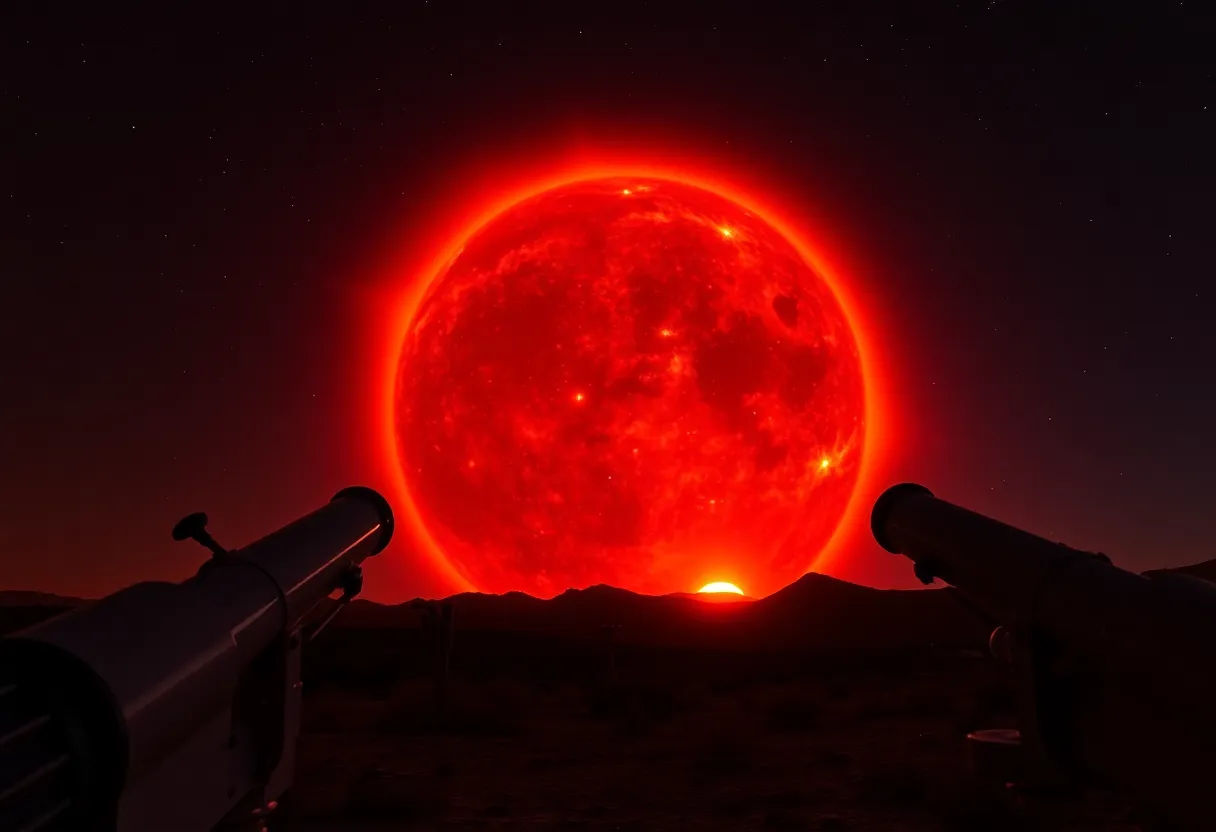Tucson, October 23, 2025
Astronomers in Tucson have reported a massive solar flare observed on October 23, lighting up the night sky visible from local observatories. Captured by University of Arizona telescopes, this spectacle raises concerns about possible impacts on global communications and power grids. While no immediate disruptions have occurred, experts emphasize the need for preparedness amid the dynamic nature of solar activity. This event underlines the importance of monitoring solar phenomena and understanding their potential implications for technology.
Massive Solar Flare Reported in Tucson
Tucson, Arizona – Astronomers in Tucson observed a massive solar flare on October 23, 2025, which lit up the night sky and was visible from local observatories. This event, captured by University of Arizona telescopes, marks a significant astronomical occurrence that could potentially affect global communications and power grids.
The solar flare, described as rare and spectacular, erupted last night and has prompted scientists to emphasize the need for preparedness. While no immediate disruptions have been reported, experts are closely monitoring the situation to assess any ongoing risks. This flare’s intensity highlights the dynamic nature of solar activity and its possible implications for modern technology.
In the initial reports, the flare’s visibility from Tucson observatories allowed for detailed observations. Scientists noted its beauty as a rare spectacle, but also stressed the importance of vigilance due to potential impacts. Such events can interfere with satellite communications, GPS systems, and even electrical grids, though the exact effects depend on various factors like the flare’s direction and strength.
Background on solar flares indicates they are sudden bursts of energy on the sun’s surface, often releasing radiation and particles into space. This particular flare is noteworthy because it was captured by local telescopes, providing valuable data for further study. Solar flares occur regularly during periods of high solar activity, but ones of this magnitude are less common and can lead to geomagnetic storms that affect Earth.
Details from the observation reveal that the flare’s potential to disrupt services stems from its ability to send charged particles toward Earth. These particles can cause disturbances in the planet’s magnetic field, leading to issues with radio communications and power distribution. Scientists in Tucson have been tracking solar activity, and this event adds to ongoing research efforts.
The University of Arizona telescopes played a key role in documenting the flare, offering high-resolution images that help in understanding its characteristics. Such observations contribute to broader scientific knowledge about the sun’s behavior and its influence on space weather. While the flare’s beauty was appreciated, the focus remains on ensuring that infrastructure is prepared for any secondary effects.
Experts suggest that societies worldwide should develop strategies to mitigate the risks associated with solar flares. This includes backup systems for critical communications and power sources. The event in Tucson serves as a reminder of the sun’s power and the interconnectedness of solar phenomena with everyday technology.
Further context on solar flares explains that they are part of the sun’s normal cycle, which peaks every 11 years or so. The current period has seen increased activity, making events like this one more likely. Astronomers use tools such as telescopes and satellites to monitor these occurrences, helping to predict and respond to potential impacts.
In Tucson, the local observatories’ ability to capture this event underscores the importance of regional monitoring stations. These facilities provide real-time data that can be shared globally, aiding in a coordinated response if needed. No disruptions have been confirmed yet, but continued monitoring is essential to track any developments.
The potential for solar flares to affect communications highlights the need for robust systems. For instance, airlines, telecommunications companies, and utility providers often have protocols in place to handle such events. This flare’s occurrence adds to the body of evidence that supports ongoing investment in space weather research and preparedness measures.
As scientists continue to analyze the data from October 23, 2025, the event in Tucson stands as a vivid example of the sun’s influence on Earth. It combines the wonder of astronomy with practical considerations for technology and safety, emphasizing the need for awareness and readiness in the face of natural cosmic events.
To expand on the details, solar flares can vary in size and strength, with this one being particularly massive. The rare spectacle observed offers a unique opportunity for education and public engagement in science. Schools and communities may use this event to discuss the science behind solar activity and its real-world effects.
In summary, the solar flare reported in Tucson on October 23, 2025, serves as a critical reminder of the sun’s power. With no immediate issues reported, experts urge ongoing vigilance to handle any potential disruptions to communications and power grids effectively.
FAQ Section
- What was observed in Tucson on October 23, 2025?
- A massive solar flare was observed, visible from local observatories and captured by University of Arizona telescopes.
- What could the solar flare impact?
- The event could impact communications and power grids, though no immediate disruptions have been reported.
- What do scientists say about the solar flare?
- Scientists urge preparedness while noting the rare spectacle’s beauty, and monitoring continues.
Key Features Chart
| Feature | Description |
|---|---|
| Date of Event | October 23, 2025 |
| Location | Observed in Tucson from local observatories |
| Captured By | University of Arizona telescopes |
| Potential Impacts | Could impact communications and power grids |
| Current Status | No immediate disruptions reported; monitoring continues |
| Scientists’ Advice | Urge preparedness while noting the rare spectacle’s beauty |
Deeper Dive: News & Info About This Topic
HERE Resources
Solar Activity Spikes in Tucson




